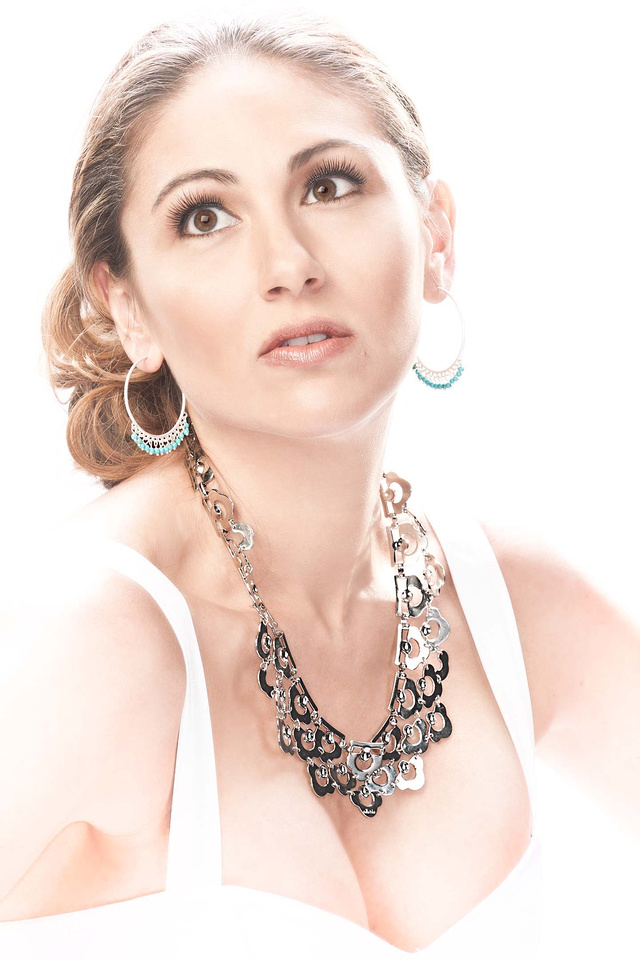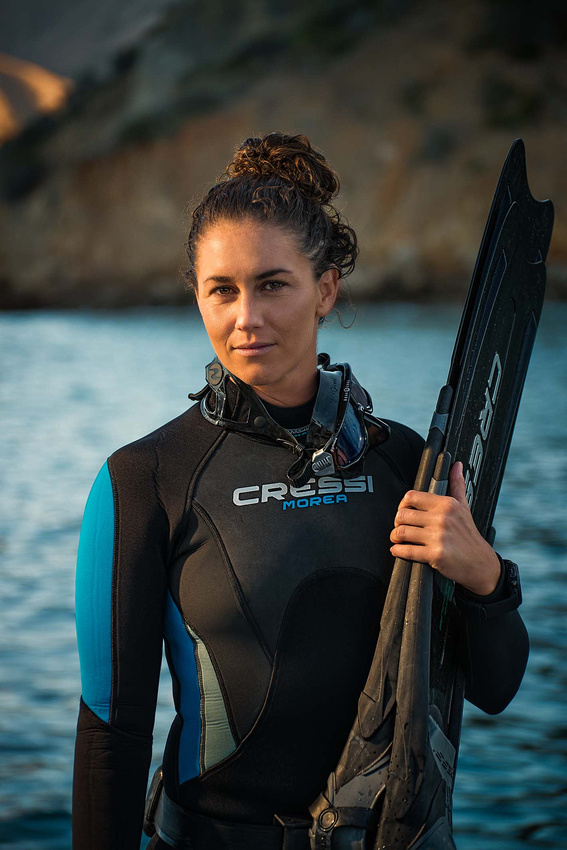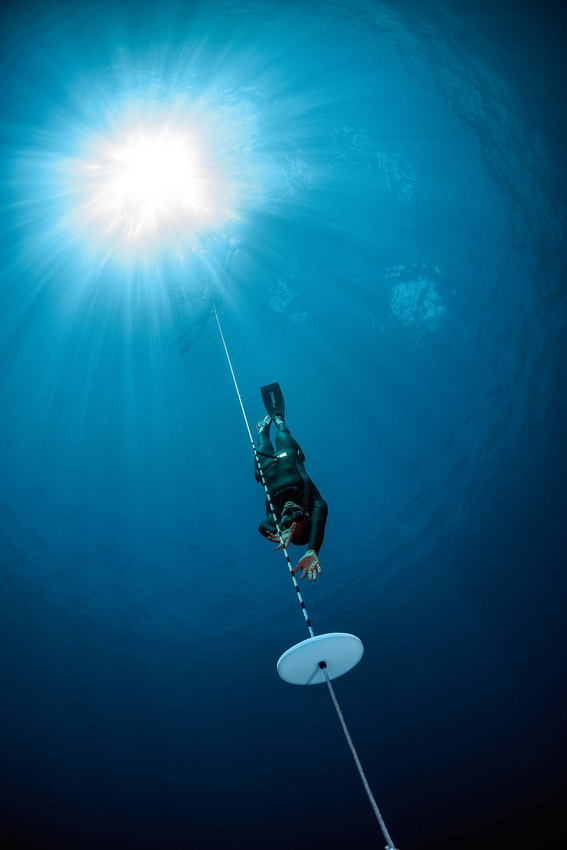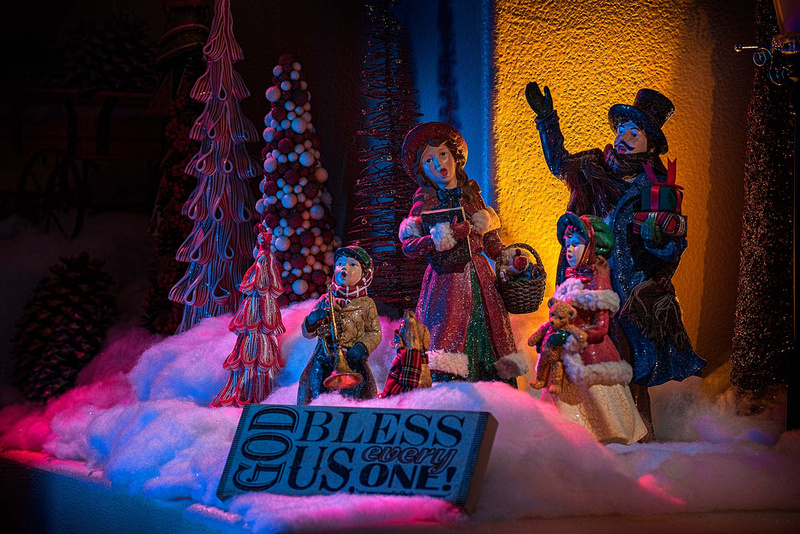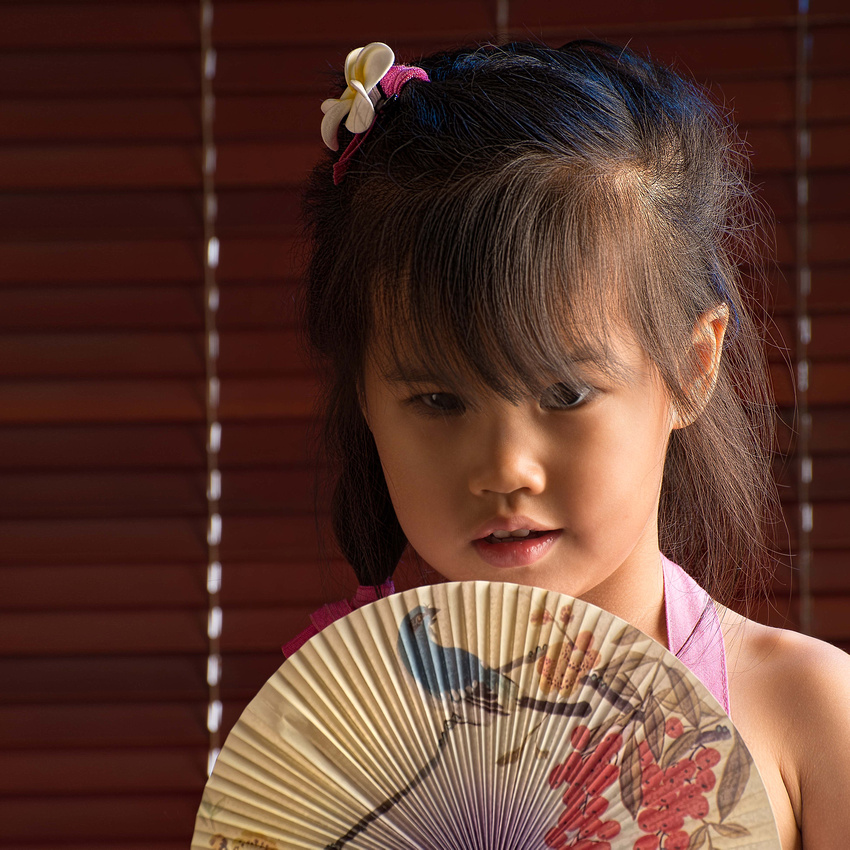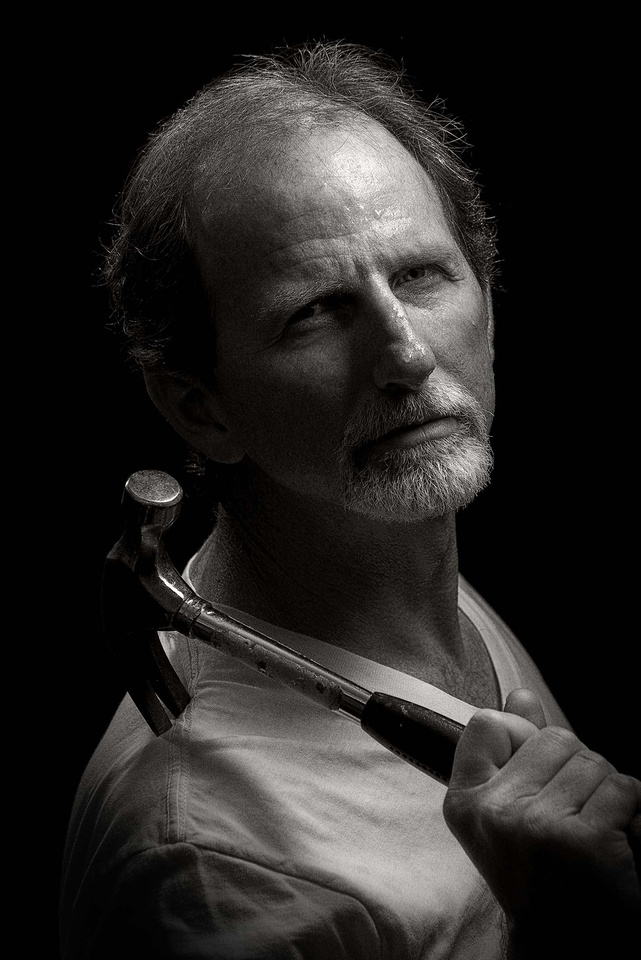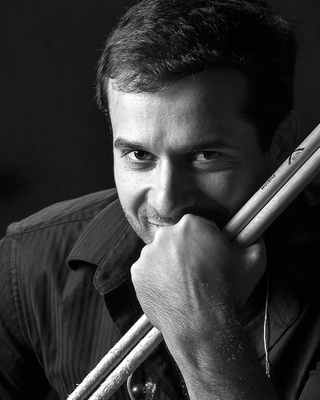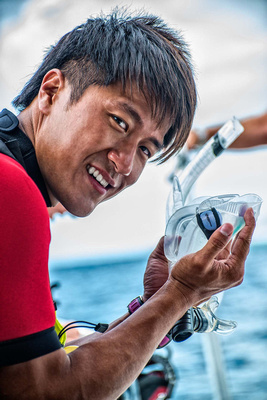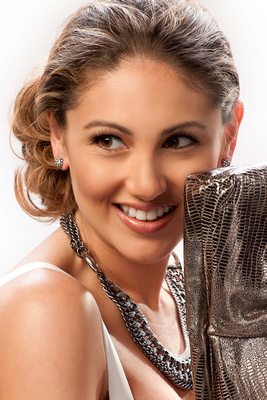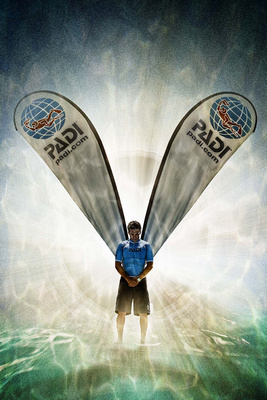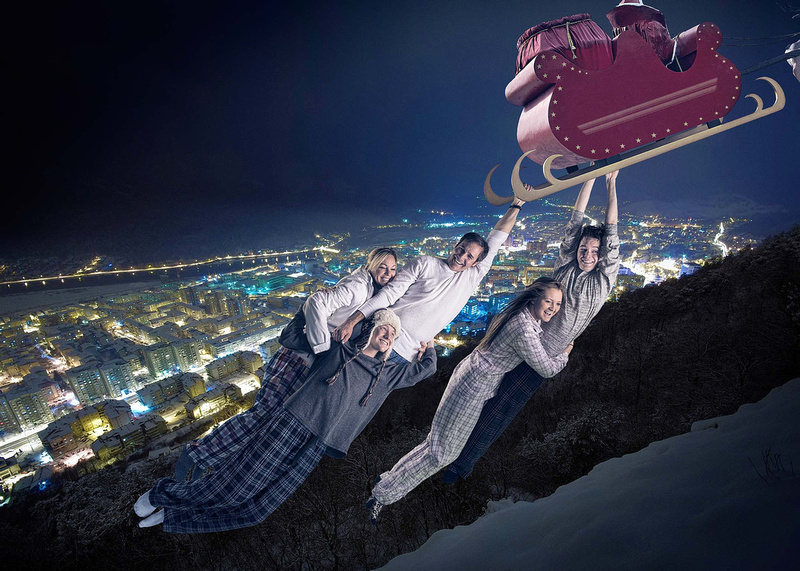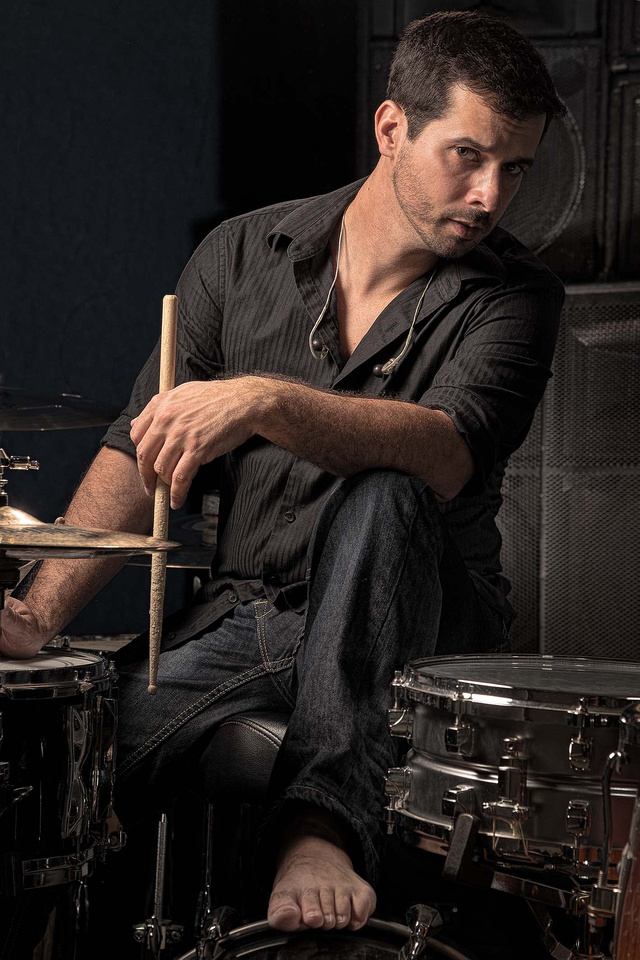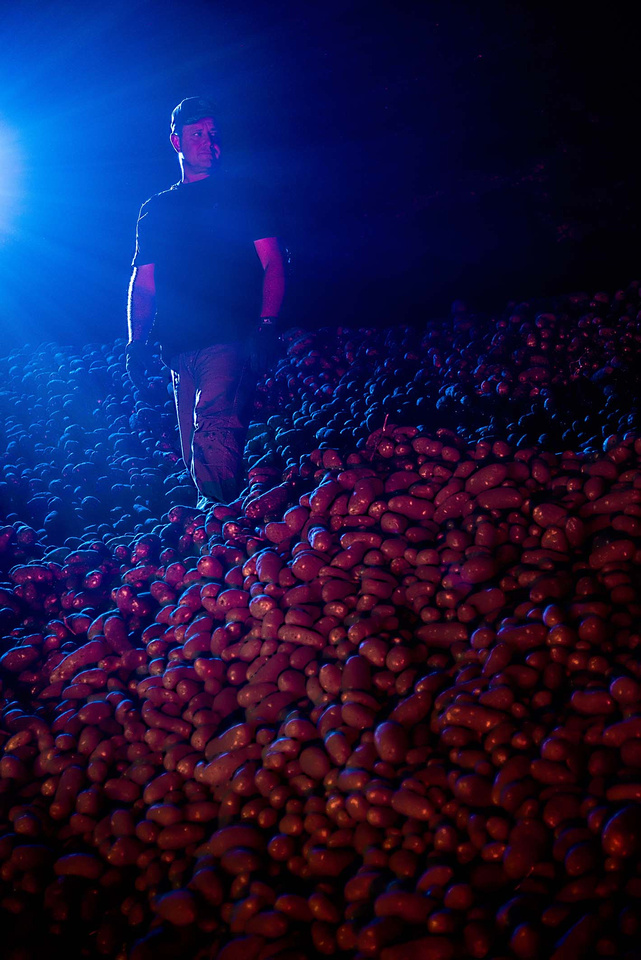|
Welcome to my online column. It's a few notes on what happens on different photo shoots and thoughts about shooting and image processing that may be useful to you if you're looking for my services as a photographic artist, or if you're a fellow shooter/image maker who works in the same areas in which I do. Light Meters Are Stupid – And Invaluable
After years of using light meters, here's what I've learned: 1. Light meters are stupid. They have absolutely no idea what the correct exposure is. 2. Light meters in the camera are even stupider and have even less idea what the correct exposure is. 3. But, I hate working without them.
When I was shooting all three of these images, the correct exposure was very different from what my light meter said. Based on it, the first image is over exposed (high key), the second is under exposed (light supplemented) and the third is over in some places and under in others (back lit with fully blocked foreground shadows).
Actually, all three are correctly exposed. Correct exposure is not an objective value. It is an artistic value based on what you're trying to accomplish in the image. So why use a light meter? Because used correctly, a light meter gives you something useful: the exposure that yields neutral gray in a given light. Unless I can't for some reason, I measure the light falling on the subject (incident metering) rather than bouncing off (reflected metering) because colors and tones alter reflected light (meters in cameras always read reflected light, btw), making it harder to determine the objective, neutral gray value. It's my job to decide what tonal value I want the final image to show, not the meter's. The meter gets me there faster by giving me a known start point. Once I know the tonal values in a setting, I set my camera (on manual) to the exposure I decide is correct, and I'm usually there with only a couple test shots and adjustments.
Yes, I know your iPhone gives you good exposures. Camera designers have gotten really good at creating light meter systems that give snapshooters good automated results in average situations most of the time. But, even with advances in the technology, these systems still struggle in many lighting conditions that, ironically, are some of the best conditions for dramatic shots. Many strong shooters use auto exposure, but no serious photographer blindly trusts automation without paying attention to what it's doing and overriding it when appropriate.
So, of course light meters are stupid. They have no brain and they have no heart. But, they're fabulous tools that your brain and heart can use when you shoot.
Photoing Freedivers
Want to model underwater? Cool, let's do a shoot where you have to hold your breath (no scuba), then swim to 50 feet (with perfect freediving form), without rushing (because I need time to compose and shoot), then leisurely return to the surface like you do it every day.
Doesn't sound easy, does it? That's why it was a joy shooting champion freediver Liz Parkinson, who does do this every day — well, practically every day. If you know anything about modern freediving, no, 50 feet isn't that deep for a moderately experienced freediver. Admittedly, for Liz, it's a milk run . . . uh, well, it would have been, except I had her to do it again and again. And again. And one more time. Make it two, but we need to go 20 feet deeper. . .
To her credit, Liz freedived dozens of times over a week for stills and video last August, with near perfect technique for every skill we needed to image, staying exactly in the light we needed her in. She made it look easy, without one complaint. When she wasn't diving for camera, she was coordinating the other models, paying attention to safety issues, wrangling sharks . . . well, it's a long list.
This frame is a popular favorite — and hey, we made the cover. So, thanks, Liz — and everyone else who modeled on that shoot.
Sometimes It Takes Light to Make Night
It started when I decided to check out some of my lighting kit, with the goal of using multiple strobes for a single shot with complex lighting. I had no idea what I would shoot, but I wanted to use only speedlights (at least a half dozen), and leave my studio monolights boxed for the duration. This is backwards from a "real" shoot, where the image dictates the hardware. In this case, I wanted to see how my hardware integrates, and to give myself a puzzle that sharpens my lighting skills.
So, what to shoot? Stumped. But, my wife had set up this figurine scene for the holidays and suggested I shoot it. Problem solved.
On to the task: Researching with Google yielded about a billion images of Christmas caroler figurines grouped in flat light on mantles, but not the idealized image of carolers at night on Christmas Eve I envisioned. My wife had built the scene with snow, Christmas trees, howling dog and the obligatory Tiny Tim quote, but I'd have do the rest with lighting. In the middle of the day. In a well lit room. The easier way would have been to wait until nightfall, but with the whole point being to challenge myself and use lots of lighting gear, I decided to do it the harder way: use light to create dark, or more specifically, to create a night Christmas look.
Without going into all the technical (leave me a message with your email address if you want the nitty-gritty), to light for night during the day, you need to use so much strobe power that you drown out the existing light. I started with multiple strobes to create the overall lighting on the figurines, but concentrated and feathered so the area around them fell into darkness. Then, I placed, aimed and gelled (colored) more until, eight speedlights later (Joe McNally would be proud), the scene looked somewhat like you might see on a fantasy nocturnal Yuletide stroll, or a least in a Nightmare Before Christmas.
Voilá, night created by light.
When All You Have Is a Hammer, You Treat Everything Like a Nail
This is as true in photography as in the garage, though for some reason, it's not as obvious to laypeople. Or even a lot of photographers.
Sometimes people remark about all the gear I bring on many of my shoots. Like the auto mechanic, I don't expect to use everything, but I want to have the right tools. Most relate to lighting because lighting makes-or-breaks the shot, yet varies more than anything else. I always plan about what I think I'll need, but sometimes clients ask for images that weren't planned ahead. Sometimes there's a cool moment I don't want to pass up. Sometimes – often – the light isn't what I expected, or it changes. Or, more commonly, all of these happen. But, no problem, because I have what I need to get the desired shots.
Often, like when I travel, I can't take my whole "toolbox." But, with good planning, what I can take covers me 99% of the time. When the remaining 1% hits, I don't waste time fussing that my Lastolite 8-in-1, or whatever, that I left in California would be perfect. I focus on what I have, apply some creativity and solve the problem without resorting to the nail treatment. As noted photographer Joe McNally said, "The most important piece of equipment in your bag is your attitude." (But, even Joe packs the lighting tools – he even helps invent them.)
This is why it amazes me when some photographers practically boast about how little equipment they have, the most common claim being that "I'm a 'natural light' photographer." Really? Would you get your car fixed by someone who says, "I'm a 10mm wrench mechanic."? Or, "I'm a hammer mechanic."? Let's be fair – some types of photography like nature, landscape and sports – appropriately don't use much lighting equipment. But, in my experience, many of the shooters who claim to be "natural light photographers" actually don't know how to light and use lighting tools. As a result, sometimes they use "natural light" when it's not what the shot calls for. All they have is a hammer, so ironically, they don't nail it but do screw it up (aren't metaphors fun?).
To be clear, I'm not dissing natural light. It's not always appropriate to have a ton of gear on a shoot, and even when I do, sometimes the only tools I need are the camera and the lens, and the lighting stuff stays boxed. And also to be clear, it's not about using gear. It's about getting the shot you want.
Look at the shot above. Depending upon the situation, I could have set it up using natural light, strobes, reflectors or a mix for the main light. Ditto for the fill and hair. Falloff to the left could come from open space or negative fill. Considering I have all of these tools at my disposal, which, you may ask, did I use?
It doesn't matter. I got the shot I wanted.
The Magic Moment: When Opportunity Meets Preparedness
No, I did not Photoshop the fish into this image. There are some shots that rely on a bit of luck, and this is one of them. But, I've noticed that skilled shooters are "lucky" a lot more often than less skilled shooters. So, maybe there's more to it than luck.
The model, Linda, and I were shooting on the Kittiwake wreck in Grand Cayman. To get the shot I wanted, Linda swam a path we established along the deck, with me shooting. For this kind of shot, it's most effective to have the model in motion, timing each capture based on body position, location and the light (not "machinegunning" – that's what amateurs do). We were just starting a second pass when I saw the fish swimming into the shot out of the corner of my eye (no small feat wearing a dive mask, BTW). I knew I would have exactly one shot to take advantage of this magic moment, and that's where discipline comes in. Don't rush, wait for it . . . . . click.
We finished the sequence, but I knew I already had the shot. A moment earlier or a moment later would have missed. If I'd just mindlessly banged off frames as fast as I could hoping I'd get it, I'd have almost certainly have had two dozen images with the magic moment falling between two of them (something I've learned the hard way). Even when shooting multiple images to get "the one," you don't mindlessly click them off by the dozens; you time each based on what's happening in the viewfinder. Today we capture more frames than we did with film, but shooting so many that you can sequence them into a movie, in most circumstances, points to a lack of skill.
The harder part in capturing magic moments, I think, is trusting that they will come. But, they will, especially if you grow them. When I was less experienced, I was a hunter trying to track down each shot and make a kill. I tried to force these moments because I had to deliver and was afraid to come home empty-handed. Today, I'm a farmer: I set the stage, set the light, and plant "seeds" with my subjects, then wait for them to grow, harvesting the magic moments that I "luck" into. I shoot fewer images than I used to, yet end up with more, better keepers.
So, while the fish swimming into the shot was pure luck, the image wasn't pure luck because we'd set the stage, set the light and planned the shot even without them. When the opportunity came, I was prepared.
Magic. Don't Confuse Image Style with Photographer Style
In photography, "style" tends to be a mushy, confusing term that can take people down the wrong path: Shooters try to be something they're not when asked to shoot "this style." Likewise, clients looking at images may pass over a photographer who might have been exactly what they're looking for because the portfolio shots or previous works "aren't the style we want."
"Style" actually means two things in photography (maybe more, but we'll say two for this point): the image's style and the photographer's style.
Image style refers to common technique: environment, lighting, angle, perspective, etc. It's not precise, but most people would agree that the first two of these three shots have the same (or at least similar) image style, and third does not:
Image style is a general look that applies regardless of who took the shot, where, etc. For example, the first two images reflect Rembrandt lighting, and this technique imparts an image look (style) that many photographers have used for decades. The third shot has an entirely different look; it has a different image style.
Photographer style is entirely different. It is that something that unifies all the works of an artist, regardless of image style. Take, for example, the works of the highly-acclaimed Annie Leibovitz. She shoots art, fashion, portrait and advertising in a myriad of image styles, yet her work is almost unmistakeable. There's something about her style that cuts across image style; it's what makes her images unique – something you will only get from her. Consider Gregory Heisler, and George Hurrell, both masters of the portrait. You'll find many different image styles in both of their works, yet there's something unmistakeable: a Heisler is a Heisler, and a Hurrell is a Hurrell. The same is true in classic art – a Monet is a Monet and a Picasso a Picasso.
Image style must change to fit the subject, or you're not doing your job as an image maker. Look at the shots below: I shoot a lot of training/scuba lifestyle images; the style I use for those is nothing like what I use for studio fashion or a portrait. And, those differ from the image style for, say, composited artistic work. Even within a genre, image style must change to fit the subject and to meet what the client needs. Shooting high fashion in a studio demands a very different approach from shooting casual fashion in the field. So, you use different tools for each of these needs. You shoot at a different pace with different lighting. You interact differently with subjects and models. You think differently because you must approach each differently.
But, across all these differences, the photographer's style doesn't change; it's the fingerprint that makes a Hurrell a Hurrell or a Leibovitz a Leibovitz. Photographer style may evolve, but one can't eliminate it or hide it. If you know my work, all six of these images are clearly my work, despite very different locations (studio, field), equipment (full studio light, run-and-gun reflectors & speedlights) and interactions (serious and methodical, quick & fun).
If you're a photographer or photographic artist, it helps to master many image styles, but your style is what makes your work singular and unique. You can't force your style into a mold, but you can help it evolve and grow by studying your craft and by shooting a lot, of course. But, don't try to shoot like Heisler or Hurrell. You can't; you just come across as a counterfeit. Learn from the masters, but shoot like you.
If you're a client who wants a particular look or feel for an image or series, don't let image style blind you to the photographer's style. That is, don't assume that because a shooter is great at a particular image style that that is the only image style the person is good at. Or, that that person can't shoot other image styles (that may be the case, but don't assume it without checking). Look at the photographer's style – the ineffable something that unites very different works from the same artist. If it works, chances are it works across many image styles. If it doesn't work for you, then you probably won't like it any better with different lighting. How They Ended Up On the South End of North-Flying Reindeer
Sometimes fun shots come together magically. Fittingly, this family Christmas card is one of those.
It started a couple weeks before the shoot with the idea that we'd do something with everyone base-jumping in parachute gear. This sounded awesome, with everyone falling at the camera (i.e., me while I shoot) and landing in foam. But, a few flaws. For one, it wasn't all that Christmassy. Second, we were having trouble getting base-jumping gear. Wayne and Karen Brown of the Ocean Adventure had generously offered to let us borrow their sky diving kit, but they were out of town and wouldn't be home in time. Then there was the small detail whether I would actually be able to get out of the way fast enough –– not just once, but the dozens of times it would take to get good images of everyone falling at me.
So, plan B was to go to an indoor skydiving facility. Flaws here were cost, plus we weren't sure we'd get permission to do the shots (we never got as far as asking though). Again, not very Christmassy. And, while I was blown away with the idea, there was a good chance I'd be blown away by the idea. So that got nixed.
Plan C was to go back to Plan A, but more Christmassy with everyone falling toward camera from out of Santa's sleigh, so no parachute kit needed, though I have it on good authority that Santa is a skydiver (which may have something to do with the reliability of reindeer-based aircraft propulsion.) So, this was the plan going into the shoot, even though we still had the can-I-get-out-of-the-way thing nagging us (well, it was nagging me).
That morning, I got up early knowing I'd need to be setting up the studio two hours ahead of the scheduled shoot time. Over coffee, I mentioned the concept to my wife, which led to some jokes about the Pixar animations, Prep and Landing (my daughter loves them). Prep and Landing shows us that Santa's sleigh launches and lands much like FA-18 Hornets coming and going from the Nimitz, and this led to jokes about what would happen if you tried to sneak aboard Santa's sleigh at launch and timed it just a hair late . . . .
Hey, that's it!
I called Ted (the dad). He liked it, too: funnier, more Christmassy, better chance of working, and added bonus, his family didn't have to change out of their pajamas. I zipped to the studio, did this set up, they arrived, we shot and a few hours in Photoshop later, everything came together like magic –- a way better creation than anything we'd imagined any time in the previous two weeks.
I guess there is a Santa Claus.
Shoeless Abe
Professional photography, at its core, is a continuous problem-solving exercise. Every shoot differs, providing something you didn't expect. That cool-and-collect attitude you see from a seasoned pro doesn't come from having seen it all. It comes from knowing that whatever comes up, you'll be able to solve it because you always have. Commissioned to shoot portraits of Soultone-sponsored drummer Abe Rodrigues of The Droppers, the challenge was that he performs barefoot. Ever heard of the baseball player Shoeless Joe Jackson? He got his nickname following a single game in which his feet were so blistered that he went to bat and ran the bases in his socks. But, shoeless isn't a one-off for Abe's sessions; it's how he usually plays. Problem is, drums hide the drummer's feet, so how do I shoot that? When he's not playing, of course. Like most good images, it started with getting the lighting dialed in so that we could let the moments happen without worrying about that. After several different shots drumming and not, Abe took a breather and leaned back, much as you see him here. Yes! But not quite there yet. We went through a few variations, and he nailed it. (Plus some others -- check them out here.) And that's the other cool thing about shooting performance artists -- they're not afraid to commit to the shot, and they know how to play to camera. It's been my privilege to shoot some talented artists over the years (magician Scott Tokar, actor/singer Thomas R. Cummings, various bands, etc.) and it's always a joy. Given the chance, I rarely turn down a chance to shoot performance artists, but I'd especially love to shoot Gwen Stefani, Ailee, or G-Dragon, if you happen to have any connections. <g>
Note: Given we're in the Christmas season, I initially thought I'd call this The Little Drummer Boy. But, Abe's not that little, nor a boy . . . . Feeding the World
Meet Kevin. He has a lot to do with the Thanksgiving meal most of us Americans will enjoy in two days. He's a Tulelake, California, farmer standing on the mashed potatoes we'll heap onto our plates next to the turkey. That's a two-story stack of potatoes – just one farm's output of one of its crops. You're seeing the tip of the tip of the tip of the iceberg. According to the American Farm Bureau Federation, only about two percent of us in the US are farmers, but it takes 15 percent of us -- 21 million people -- to process, pack and ship what they turn out. Thanks to what they do, we only have to spend about 10 percent of our disposable income on food, yet incredibly, a third of America's agricultural output gets exported. Last year, the US exported more than 30 billion metric tons in wheat alone. We raise nearly half of the world's soybeans and corn. All-in-all, every America farmer feeds 140 to 155 people (sources vary on this estimate) around the world. Fifty years ago, it was about 26. Yes, we import a lot of food, too, but we export more than we bring in. American farmers work long days (actually, they work long hours – their "days" often start and end in the dark), with an average estimated return of only about 12 to 16 cents on the dollar. That's about half the return they had 30 years ago, by the way, without adjusting for inflation. And, it takes a lot of dollars to farm today. Take for examples, which start, with the required attachments, at $100,000 but can cost twice that. American farmers produce more than ever before, and will likely have to do even more over the next 15 years as global populations rise. Even with growing demand and lower returns, though, our farmers are increasing their sustainability and green practices. Most farms conserve large wildlife areas, plant trees and other plants and increasingly implement sophisticated agricultural practices so that they need less water, fertilizer etc. per acre than a few decades ago. Farms are the main developers of alternative energies, and the primary users of some forms. It's not an easy life, but thank God they do it. Next time we sit down to dinner – especially at Thanksgiving – and say grace, perhaps we could add a word of blessing and thanks for Kevin, his family and all the other farm families who literally feed the rest of the world.
|
